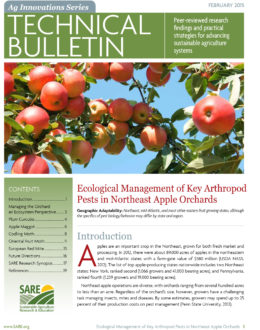Apples are an important crop in the Northeast, grown for both fresh market and processing. In 2012, there were about 89,000 acres of apples in the northeastern and mid-Atlantic states with a farm-gate value of $580 million (USDA NASS, 2012). The list of top apple-producing states nationwide includes two Northeast states: New York, ranked second (1,066 growers and 41,000 bearing acres), and Pennsylvania, ranked fourth (1,239 growers and 19,000 bearing acres).
Northeast apple operations are diverse, with orchards ranging from several hundred acres to less than an acre. Regardless of the orchard’s size, however, growers have a challenging task managing insects, mites and diseases. By some estimates, growers may spend up to 25 percent of their production costs on pest management (Penn State University, 2012).
Pest management challenges are compounded by three factors:
- high cosmetic standards and low tolerance for damage in fruit marketed for fresh consumption;
- regulatory pressures and health concerns regarding organophosphate insecticides;
- the changing nature of the pest complex due to: 1) adaptations of existing pests, and 2) the emergence of new pests, resulting from climatic variation and shifts in host preference.
In response to these challenges, SARE funded three projects, one in Massachusetts and two in Pennsylvania, to help develop alternative management strategies for apple pests in northeastern orchards. This technical bulletin outlines strategies developed from these projects, including biologically based pest control, orchard architecture and development of materials approved for organic production.
At the time of funding (2000-2009), the key arthropod pests in Northeast apple orchards were: European red mite (Panonychus ulmi), plum curculio (Conotrachelus nenuphar), apple maggot (Rhagoletis pomonella) and leafroller complex including obliquebanded leafroller (Choristoneura rosaceana) and tufted apple bud moth (Platynota idaeusalis). Today, apple maggot, plum curculio and European red mite continue to be important problems for northeastern growers while a number of new arthropod pests have also emerged, including codling moth (Cydia pomonella) and Oriental fruit moth (Grapholita molesta). This bulletin focuses on these five pests.
For more information on pest management in apple orchards, watch the New England Apple Association's three-part video series, New England Apple Growers Battle Pests with IPM.
Want more information? See the related SARE grants:
